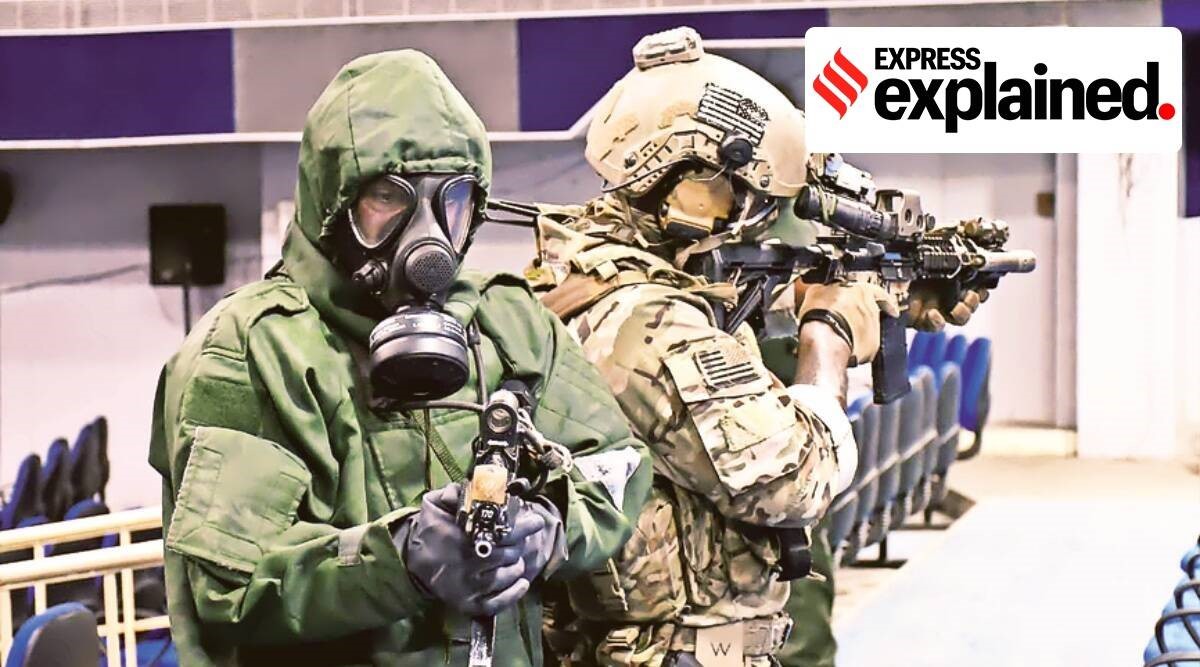Description

Copyright infringement not intended
Context: An ongoing Indo-US joint exercise, named TARKASH, has for the first time included “Chemical, Biological, Radiological and Nuclear (CBRN) terror response” in its drill.
Details:
About Tarkash:
- TARKASH is a joint exercise by the National Security Guard (NSG) and US Special Operations Forces.
- The exercise also included a drill for tackling chemical and biological attacks by terrorists.
- According to the report, the new drill has been made part of the exercise in the backdrop of the Russia-Ukraine war.
- Last year, Russia accused Ukraine of orchestrating a chemical attack in Kharkiv to blame Russia and receiving aid from the western countries.
.jpeg)
How are the NSG and SOF preparing for the CBRN terror response?
- The drill for CBRN terror response “involved small team insertion by IAF helicopters to the target area, successful intervention in a large auditorium, rescue of hostages and neutralisation of the chemical agent weapon.”
- The exercise also included a drill for tackling chemical and biological attacks by terrorists.
- the mock validation exercise involved a terrorist organisation armed with chemical agents threatening to attack a convention hall during an international summit.
What are CBRN weapons?
- CBRN weapons have the capability of creating mass casualties as well as mass disruption and therefore, are classified as weapons of mass destruction.
- According to a 2005 study, the range of these weapons is quite extensive.
- Chemical weapons include mustard gas (damages the respiratory tract, skin, and eyes) and nerve agents (victims rapidly become unconscious, have breathing difficulties, and may die).
- Biological agents like anthrax (causes fever, malaise, cough, and shock. Death can be within 36 hours), botulinum toxin (leads to paralysis of respiratory muscles) and plague are some examples of biochemical weapons.
- Radiological weapons include weaponised radioactive waste and dirty bombs as well as nuclear weapons.
Historical Background:
- Over the years, they have been used by several countries and terrorist organisations.
- The first instance of any form of CBRN weapons being used in modern warfare can be traced back to World War I.
- The French forces, during the first month of the war, deployed tear-gas grenades that they had developed in 1912 for police use.
- Later, Germany, in October 1914, fired shells containing dianisidine chlorosulfate, a lung irritant, at the British army at Neuve-Chapelle in France.

Geneva Protocol:
- After the war ended, countries came together to sign the Protocol for the Prohibition of the Use in War of Asphyxiating, Poisonous or other Gases, and of Bacteriological Methods of Warfare, also known as the Geneva Protocol, on June 17, 1925, at Geneva.
- The treaty prohibited the use of “asphyxiating, poisonous or other gases, and of all analogous liquids, materials or devices” and “bacteriological methods of warfare”. It entered into force on February 8, 1928.
Violation of the Protocol:
- However, in the following years, numerous countries violated the treaty.
- For instance, Italy used mustard-gas bombs in Ethiopia to destroy Emperor Haile Selassie’s army in 1936. During World War II, Nazi Germany used poisonous gases to kill prisoners in concentration camps.
- The Americans used napalmand the herbicide Agent Orange during the Vietnam War.
- Then, in the 1980s, Iraq used chemical weapons against Iran and Iraq’s Kurdish minority during the Iran-Iraq war. The use of chemical weapons by Iraq was later confirmed by the United Nations.
- Most recently, the use of CBRN weapons came in the form of a sarin gas attack carried out by the Syrian army in 2013 against civilians during the Syrian Civil War.


https://indianexpress.com/article/explained/indo-us-joint-exercise-what-are-cbrn-weapons-tarkash-8442357/
















